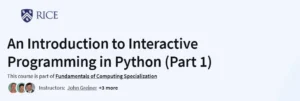What will you learn in A Complete Guide to Java Programming Course
Understand Java’s core paradigms—object-oriented and procedural programming—and how they map to real-world applications
Work fluently with Java fundamentals: objects, data types, variables, arrays, and control structures
Master iterative constructs, algorithms, and data structures through hands-on coding challenges
Apply exception handling and use Java’s rich I/O and collection frameworks for robust programs
Set up your Java development environment—JDK, IntelliJ IDEA, and Apache Commons Lang—for professional workflow
Program Overview
Module 1: Java, a High Level Language with a Purpose
⏳ 26 minutes
Topics: What makes Java high-level; memory management (heap vs. stack) and application benefits
Hands-on: Quiz Yourself on Java Basics and explore memory allocation exercises
Module 2: How Java Programming Works
⏳ 15 minutes
Topics: Procedural vs. OOP paradigms; Java class structure and program entry points
Hands-on: POP vs. OOP quiz and “Java Program is Written Within a Class” exercise
Module 3: Objects and Data Types
⏳ 46 minutes
Topics: Object characteristics, primitive vs. reference types, and naming conventions
Hands-on: Variable declaration and compute-sum challenges with solution reviews
Module 4: Variables: The Name of a Field
⏳ 41 minutes
Topics: Field vs. local variables, scope rules, and access modifiers in Java
Hands-on: Declare class attributes, explore reference vs. local variables exercises
Module 5: Arrays: The Container Objects
⏳ 51 minutes
Topics: Declaring, initializing, and manipulating arrays; using Apache Commons Lang helpers
Hands-on: Compute sum-of-array challenge and review sample solutions
Module 6: Operators and Conditional Statements
⏳ 41 minutes
Topics: Arithmetic, relational, instance-of, and conditional operators; control flow constructs
Hands-on: Decimal-to-binary conversion challenge with solution walkthrough
Module 7: Iterative Constructs, Entry and Exit Controlled Loops
⏳ 31 minutes
Topics: ‘for’, ‘while’, and do-while loops; fixed vs. unfixed iteration patterns
Hands-on: Loop examples exercises and quiz on iterative constructs
Module 8: Algorithms
⏳ 56 minutes
Topics: Introduction to algorithms; solving Fibonacci, reversal, and numeric-sum problems
Hands-on: Multiple algorithmic challenges (Fibonacci sum, reverse number, odd-negative sums)
Module 9: Basic Input and Output
⏳ 10 minutes
Topics: Using
Scannerfor console I/O and best practicesHands-on: Input/output quiz based on real-world scenarios
Module 10: Classes and Objects
⏳ 26 minutes
Topics: Defining classes, object instantiation, and polymorphism basics
Hands-on: Classes-and-objects quiz with examples
Module 11: Interface and Abstraction
⏳ 10 minutes
Topics: Designing abstractions and implementing interfaces for flexible code
Hands-on: Interfaces and abstraction quiz
Module 12: Exception Handling and Data Structures
⏳ 15 minutes
Topics: Try/catch constructs and an overview of Java’s data structures
Hands-on: Exception-handling quiz
Module 13: Conclusion
⏳ 5 minutes
Topics: Continuous practice strategies and navigating Java documentation
Hands-on: Wrapping-up reflection exercise
Module 14: Appendix
⏳ 15 minutes
Topics: Installing JDK, IntelliJ IDEA setup, and integrating Apache Commons Lang
Hands-on: Environment setup tasks and configuration checks
Get certificate
Job Outlook
Java Developers earn an average base salary of $136,284 USD per year in the U.S.
Employment of software developers is projected to grow 21% through 2030, driven by enterprise, mobile, and cloud applications
Skills in Java, algorithms, and data structures open roles in finance, e-commerce, and large-scale backend systems
Proficiency in Java development tools and best practices boosts prospects for senior engineering and architecture positions
Specification: A Complete Guide to Java Programming
|





